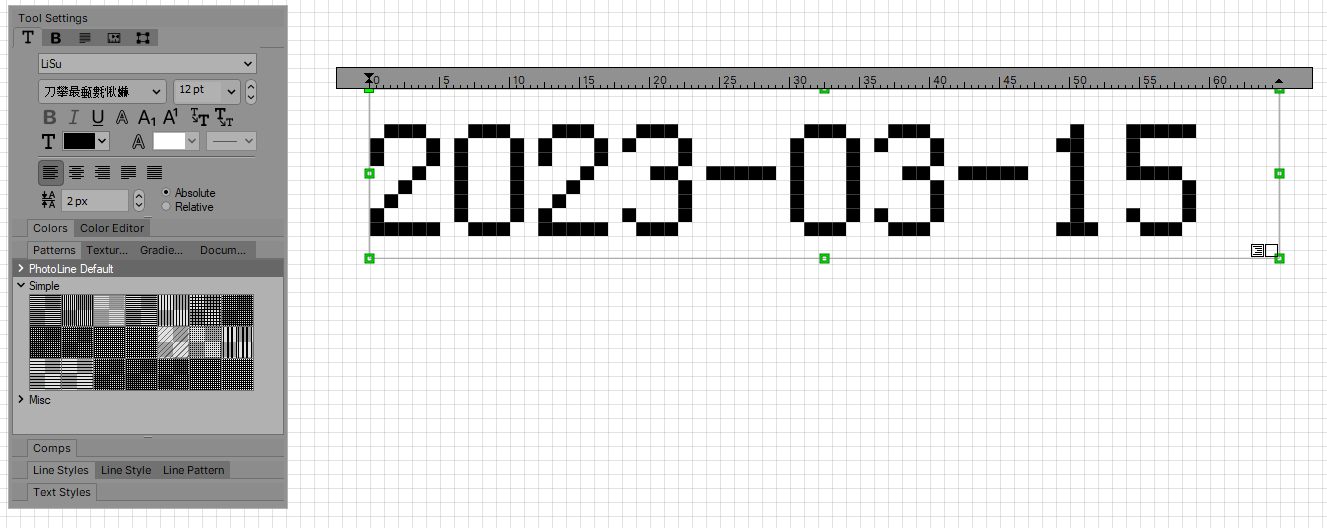-
Posts
670 -
Joined
-
Last visited
Recent Profile Visitors
-
 earl_grey reacted to a post in a topic:
Change of interpolation type when scaling elements
earl_grey reacted to a post in a topic:
Change of interpolation type when scaling elements
-
 Frozen Death Knight reacted to a post in a topic:
Change of interpolation type when scaling elements
Frozen Death Knight reacted to a post in a topic:
Change of interpolation type when scaling elements
-
I agree with @earl_grey. Affinity doesn't allow for sufficient control over layer sampling algorithm nor (anti-)aliasing control. These issues are the source for recurring issues and requests over the years since Affinity was first released. As an example of how this may be implemented, compare with PhotoLine and Krita: In PhotoLine the layer properties allow the user to easily control: the anti-aliasing (on or off) the resampling algorithm when a layer is scaled (also used when layers are exported) pixel snapping ...for each individual layer(!). The resampling method is set for bitmap layers only (for obvious reasons). And additional resampling algorithms are available that help retain crispness of scaled-down art (CatmulRom). In Krita: Again the resampling algorithm is easily controlled. And again transformation of the OP's example results in a straight transformed pixel row. Simple and effective. It'd be great if the Affinity devs would afford Affinity users the same level of control over the resampling method. That said, I am happy to see that we now have access to a Force Off anti-aliasing option for layers in Affinity. But that behaviour should be consistently implemented throughout other actions, such as transformation. When I transform pixels like the OP's example and stretch a column of pixels in Krita and PhotoLine, the result will be a simple repetition of those pixels when stretched horizontally. (In PhotoLine anti-aliasing is best turned off to prevent anti-aliased edges.) But that doesn't happen in Affinity. It still adds strongly blurred anti-aliasing and results in that strange blurred result. That makes it almost impossible to use for scaling pixel art elements or even stretching bitmap-based GUI elements. Which once more is a good example of "close, but no cigar". I've checked tutorials online, and the vague blurred edges are apparent in images like the one here: https://www.digitalcameraworld.com/tutorials/create-a-head-turning-pixel-stretch-effect-in-the-budget-friendly-affinity-photo Notice how the band of stretched pixels blurs toward the edges. Unless I am missing something here? Does an option exist to avoid this unwanted behaviour in Affinity (Photo)?
- 5 replies
-
- 2.3
- affinity photo
-
(and 5 more)
Tagged with:
-
 debraspicher reacted to a post in a topic:
How to change text rendering to None like PS?
debraspicher reacted to a post in a topic:
How to change text rendering to None like PS?
-
 Sreng Pagna reacted to a post in a topic:
How to draw different shapes in one layer in Affinity Designer 2
Sreng Pagna reacted to a post in a topic:
How to draw different shapes in one layer in Affinity Designer 2
-
Draw the first shape with the pen. Then activate "Add New Curve to Selected Curves Object" in the pen tool options. The next curve will be part of the same vector layer. But if you change colour of either the fill or the stroke, all shared vector objects will change colour. The behaviour that you @Sreng Pagna want isn't possible in Designer as far as I am aware. Flash and Moho work differently with vectors in that regard. In Moho and Flash multiple vector elements may exist on the same "layer" and each element may have its own stroke and fill settings. In other vector illustration software (Illustrator, Affinity Designer, VectorStyler, Inkscape, etc.) this is typically not the case: unless a vector shape is a separate object, i.e. on its own 'layer', these shapes will share the same stroke and fill settings. Animation software that works with vectors tends to work slightly different. OpenToonz also allows for multiple vector objects on the same layer while each shape is assigned its own colour settings. I suppose the "sublayers" are hidden from the user in Moho, Flash, and OpenToonz. In the end it doesn't matter: when you draw multiple shapes in multiple vector layers in Affinity Designer, export your work as SVG and import as SVG in Moho. Moho will import these as a singular vector layer (delete the bitmap layer at the bottom after import). Then continue as you did before in Moho. So the fact that Designer works with different vector object layers doesn't have any impact after import into Moho.
-
 SallijaneG reacted to a post in a topic:
Canva
SallijaneG reacted to a post in a topic:
Canva
-

Canva
Medical Officer Bones replied to Ash's topic in Affinity on Desktop Questions (macOS and Windows)
That's what you get when taking things too seriously. You've completely misunderstood my words. It is because I fully realize how limited our lives are and that planning only goes so far, that I live each day to the fullest I can. That I enjoy every little moment, every experience, every encounter (that includes negative ones). Anyone who knows me in my real life knows me for my unbridled optimism. And I look at the universe and the world with that same hope and optimism; and awe as if I were still a child. We don't know what we don't know. As conscious beings we are but an infinitesimal part of the whole that is the universe, a part that coalesces like a tiny vortex in a river that appears and seamlessly merges back in a infinitesimal moment, yet we still fill it through our uniqueness and influence the next moments, even if we exist but for that short moment. Being aware of this interconnection and fragility liberates one to a tremendous freedom. The world is wonderful and existence fragile. If more people would fully realize this, humanity wouldn't make such as mess. Anyhoo... Back to our regular programming 🙂 Only the future will tell us how this Canva story will unfold for Affinity. As I said, I hope for the best, and expect the worst. Affinity's continued development falls outside my tiny sphere of influence. I've purchased V1 and V2, and will purchase V3 hopefully (see what I did there?). -

Canva
Medical Officer Bones replied to Ash's topic in Affinity on Desktop Questions (macOS and Windows)
Of course we plan ahead. Yet expect our plans to be thwarted at every turn and hope for lady luck to deign us her favour. And doubt is our guide. All the while we take care to avoid taking ourselves too seriously, because our ending is just around the corner and our time on this tiny planet in a tiny corner in our unimaginably big and old universe represents but an infinitesimal flicker and is even quicker forgotten. So we laugh back at the gods! And learn of the purpose of the universe in a blade of grass. -
 Medical Officer Bones reacted to a post in a topic:
Canva
Medical Officer Bones reacted to a post in a topic:
Canva
-
 Medical Officer Bones reacted to a post in a topic:
Canva
Medical Officer Bones reacted to a post in a topic:
Canva
-

Canva
Medical Officer Bones replied to Ash's topic in Affinity on Desktop Questions (macOS and Windows)
Man plans, the gods laugh! -

Canva
Medical Officer Bones replied to Ash's topic in Affinity on Desktop Questions (macOS and Windows)
@SrPx Words are merely words. Actions will prove their value in the upcoming 1 or 2 years. Then we shall see what worth these words have. As always: hope for the best, expect the worst. Cheers! -

Canva
Medical Officer Bones replied to Ash's topic in Affinity on Desktop Questions (macOS and Windows)
@SallijaneG You feel that looks anywhere close to acceptable? ...how times are a-changing... -

Canva
Medical Officer Bones replied to Ash's topic in Affinity on Desktop Questions (macOS and Windows)
Ah yes: "pledges". Like the ones given when Zbrush was acquired by Maxon. Did not take long to conveniently forget about those after one slender release. Then full subscription. Or past pledges given by Maxon and Autodesk. Or Adobe. Or Unity... Pledges by companies mean NOTHING in contexts like this one (buyout). Where were these pledges when the buyout was announced? Right, not on their minds. The community rears up in arms in response, which is utterly predictable. Management and ex-owners of Affinity don't feel good about themselves. "People are mad with us!" "Look at all that negative publicity! Oh no!" So "pledges" are conceived and published to allay public fears of the populous. Now small part of loyal user base quiet down and help quiet down most of the unrest. "Have no fear, friends! Management has explained that there is nothing to fear! All will be well!" Two years later the first release without perpetual. And/or bloatware. And/or hardly any worthwhile updates anymore. We will see. If history taught us anything so far: these pledges mean NOTHING. Only ACTIONS. And these actions so far have been... disappointing. -
@dominik We all have different needs and workflows. As long as we have alternatives to work with, it's fine. PhotoLine is not perfect: no software is. But I worry about the impoverishment in (semi-)professional image editors. While GIMP is nice for what it is, a true Blender grade open source image editor equivalent is still missing.
-
 Medical Officer Bones reacted to a post in a topic:
It was good while it lasted. Where do you plan to go now?
Medical Officer Bones reacted to a post in a topic:
It was good while it lasted. Where do you plan to go now?
-
 Medical Officer Bones reacted to a post in a topic:
Canva
Medical Officer Bones reacted to a post in a topic:
Canva
-
 Medical Officer Bones reacted to a post in a topic:
Canva
Medical Officer Bones reacted to a post in a topic:
Canva
-

Canva
Medical Officer Bones replied to Ash's topic in Affinity on Desktop Questions (macOS and Windows)
? Why would you use Canva for webp conversion when that can be done for free in https://squoosh.app/ ...and if you download the source code from their GitHub, Squoosh runs in a local LAMP such as Mamp or Xampp as well - basically, off-line. And you gain AVIF support! WebP can't compare to AVIF. -
Canva is generally despised by design professionals. A 'dirty' word. It is a design block/template service, its design software is web-based and woefully imprecise, and it allows non-designers in business and office environments to play designer. Design professionals have to deal with the fall-out. Inconsistent company branding and communication, having to work with JPG files that are delivered to them for "final print delivery"... Designs that feel generic or all over the place. Clients have delivered Canva work to colleagues of mine, and they had to redraw and rebuild the entire designs in Illustrator. Canva acquiring Affinity is, as someone in another forum stated:
-
Well, Affinity always has been (and still is) a secondary app for myself. My main hub is PhotoLine. I also use Clip Studio EX and Krita. For myself I consider PhotoLine the only real alternative to Photoshop, mainly because 1bit image support is lacking in Affinity, and I need that for my work. And PhotoLine also offer a good solid set of vector editing tools. While PhotoLine doesn't support AI tools, I now use Krita with its free AI plugin to balance that out together with its painting tools (which are okay in PhotoLine, but can't compete with Krita or Affinity). Clip Studio EX I use for comic work and publication. To me PhotoLine is that Swiss knife app that holds my workflow together. And does it well. Affinity never was able to.
-
 Medical Officer Bones reacted to a post in a topic:
Canva
Medical Officer Bones reacted to a post in a topic:
Canva
-

Canva
Medical Officer Bones replied to Ash's topic in Affinity on Desktop Questions (macOS and Windows)
You are absolutely right. A more-or-less deflated demeanour. He's not feeling it. This is not a happy guy. Of course, the exact reason for his mood can't be exacted from the video alone. There is probably stuff going on in the background. He probably does feel guilty about going back on early made promises that they'd never sell out or go subscription. But hey: money talks. It takes a special type of person or company to resist money. Almost no-one will or can. So great news for the Affinity owners. Much less so for its customers. We all know where this is heading for. Ample prior examples in the industry. As for myself, I'm glad I only use Affinity as a secondary piece of design software. My workflow isn't affected much, luckily enough. V3 will be sub: that much is clear. Canva will have a detrimental impact. That much is clear too. I already experienced so many of these acquisitions and I used to feel sad and betrayed. No longer the case, because I expected this to happen at some point to Affinity. I hoped it would not. Yet expected it. Still, I wanted and hoped to be wrong. -
 Medical Officer Bones reacted to a post in a topic:
Canva
Medical Officer Bones reacted to a post in a topic:
Canva
-

List of some third party vectorization & tracing tools
Medical Officer Bones replied to v_kyr's topic in Resources
Throwing a left-field curve ball here and mention OpenToonz. 🙂 OpenToonz features an excellent bitmap to vector conversion tool that works for both center line as well as outlined vectors. It will convert black and white and colour art, and works on multiple drawings for animations too! The result can be exported as SVG. Also handy: the built-in bitmap/scan cleanup tools make short work of cleaning up art/sketches before conversion to vectors. All for free in this open source animation software (both Windows and Mac) which is used in traditional hand-drawn animation (such as in Mary and the Witch's Flower). The only drawback is that it will take more of an initial learning effort, but it isn't that hard. https://opentoonz.github.io/e/ Tutorial:- 63 replies
-
- vectorization
- tracer
-
(and 5 more)
Tagged with:







